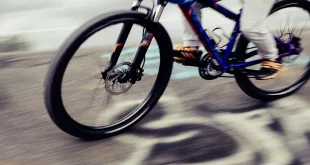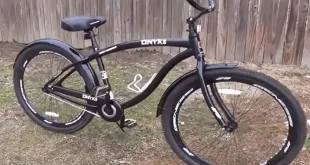Yes, bicycle handlebars are interchangeable, allowing riders to customize their bike’s handling and comfort. Bicycle handlebars can be easily swapped out for different styles or sizes to suit a rider’s preferences and performance needs.
Whether you prefer flat bars for a more upright riding position, drop bars for aero efficiency, or riser bars for more control on rough terrain, there are various options available in the market. Additionally, handlebars can also be adjusted in terms of width and reach to achieve a comfortable fit.
Interchangeable handlebars offer cyclists the flexibility to personalize their riding experience and optimize their bike’s handling characteristics. So, if you’re looking to upgrade or modify your bike’s handlebars, rest assured that it is a possibility.
Understanding Handlebar Measurements
When it comes to customizing your bicycle, handlebars play a crucial role in providing comfort and control. However, it’s important to understand that not all handlebars are interchangeable. Different bicycles have varying handlebar measurements, and it’s essential to choose the right size for your bike.
In this section, we will delve into the intricacies of handlebar measurements and why they are important for ensuring compatibility with your bicycle stem.
Explanation Of Handlebar Diameter And Clamp Size:
- Handlebar diameter refers to the thickness of the handlebar where it connects to the stem. It is crucial to choose a handlebar with the correct diameter to ensure a secure fit.
- Clamp size, on the other hand, refers to the diameter of the stem where it clamps onto the handlebar. The handlebar’s clamp size should match that of the stem to guarantee a proper and safe attachment.
The Relationship Between Handlebar Measurements And Stem Compatibility:
- Handlebar measurements, including diameter and clamp size, directly impact the compatibility with the stem. A mismatch in measurements can lead to instability, compromise bike handling, or even pose a safety risk.
- It is essential to check the specifications provided by the manufacturer to ensure the handlebar and stem are compatible in terms of measurements.
Why It’s Crucial To Choose The Right Handlebar Size For Your Bicycle:
- The right handlebar size ensures comfort and control while riding. A handlebar that is too narrow or too wide can result in discomfort, reduced maneuverability, and even pain or numbness in the hands.
- Choosing the appropriate handlebar size based on your riding style and body proportions can optimize your riding experience, allowing for better bike handling and reduced strain.
Now that we understand the importance of handlebar measurements and their impact on stem compatibility, it’s time to delve further into how to choose the right handlebar size for your bicycle.
Types Of Handlebars
When it comes to customizing your bicycle, one of the key components that can greatly impact your riding experience is the handlebars. Different types of handlebars offer unique characteristics and benefits, catering to various cycling styles and preferences. We will explore the different types of handlebars commonly used by cyclists and discuss whether they are interchangeable or not.
Flat Handlebars:
- Flat handlebars are a popular choice for mountain bikers and casual riders.
- They provide a more upright riding position, offering better control and visibility.
- These handlebars are typically wider, allowing for stability and improved handling on rough terrains.
- With a simple and straightforward design, they are easy to install and adjust.
- Flat handlebars are not compatible with drop bar shifters used in road bikes and may require different brake mechanisms.
Drop Handlebars:
- Drop handlebars are commonly found on road bikes and are designed for speed and aerodynamics.
- They offer multiple hand positions, allowing you to switch between a more upright position and a lower, more aerodynamic one.
- The drop position provides better leverage for powerful pedaling and improved control in descents.
- Drop handlebars are not compatible with mountain bike shifters and may require specific brake levers for efficient braking.
Riser Handlebars:
- Riser handlebars are often seen on mountain bikes and provide a more comfortable and upright riding position.
- They are designed to reduce strain on the wrists and provide better control on technical terrains.
- Riser handlebars can be adjusted to different heights and angles to suit individual preferences.
- They are not compatible with road bike shifters and may require different brake levers for proper functionality.
Aero Handlebars:
- Aero handlebars, also known as triathlon or time trial handlebars, are designed for maximum aerodynamic efficiency.
- They allow cyclists to assume a more tucked position to reduce wind resistance and increase speed.
- Aero handlebars can feature integrated shifters and brake levers, improving aerodynamics and reducing clutter.
- Due to their specialized design, aero handlebars are not interchangeable with other types of handlebars.
Bullhorn Handlebars:
- Bullhorn handlebars have a unique design that resembles the horns of a bull.
- They offer multiple hand positions and are commonly used for street and urban riding.
- Bullhorn handlebars provide a comfortable grip and better leverage for climbing.
- They can be installed on most bicycles with the right stem and are relatively easy to adjust.
While there are various types of handlebars available for bicycles, they are not necessarily interchangeable. The type of handlebars you choose should align with your cycling style, intended use, and the components already present on your bike. It is important to consider compatibility factors such as shifters, brake levers, and stem size when selecting and installing handlebars for your bicycle.
By understanding the characteristics and benefits of each type, you can make an informed decision that enhances your riding experience.
Compatibility Factors
It’s a question that many cyclists ask themselves when seeking to customize their ride or replace a damaged handlebar. The good news is that bicycle handlebars can often be interchangeable, allowing riders to find the perfect fit for their needs and preferences.
However, there are a few key factors to consider when determining handlebar interchangeability. We’ll explore these compatibility factors in more detail so you can make an informed decision. So, let’s dive in!
Factors To Consider When Determining Handlebar Interchangeability:
- Clamp diameter compatibility with stem: One of the first things to consider is the clamp diameter of the handlebar and whether it matches the stem on your bicycle. Most handlebars come in standard sizes, such as 31.8mm or 25.4mm. Ensure that the handlebar you’re considering has a compatible clamp diameter to ensure a secure fit.
- Compatibility with brake and shift levers: Another important factor is the compatibility of your chosen handlebar with your brake and shift levers. Different handlebars have varying shapes, bends, and integrated components that may affect the placement and operation of your levers. Make sure to check if your existing levers are compatible or if you may need to make adjustments.
- Understanding handlebar reach and drop: Handlebars come in different shapes and sizes, each offering different reach and drop measurements. Reach refers to the horizontal distance from the center of the handlebar to the furthest point forward, while drop is the vertical distance from the top of the handlebar to the bottom. It’s crucial to consider these measurements and select a handlebar that aligns with your riding style and comfort preferences.
By taking these compatibility factors into account, you can ensure that your new handlebar is suitable for your bicycle and provides a comfortable riding experience. Consider consulting with a local bike shop or an experienced cyclist if you’re unsure about compatibility or need assistance in selecting the right handlebar for your needs.
Remember, finding the right handlebar that suits your riding style, comfort, and compatibility needs is essential for an enjoyable cycling experience. So, take your time, do your research, and make an informed decision.
Considerations For Handlebar Swaps
Handlebars are an essential component of a bicycle, providing stability, control, and comfort during rides. However, there may be instances when you want to swap your handlebars for various reasons. Whether you’re looking to switch between road bike and mountain bike handlebars or changing within the same category, there are some considerations to keep in mind to ensure compatibility.
Let’s explore these factors in more detail.
Road Bike To Mountain Bike Handlebar Swaps
When transitioning from road bike to mountain bike handlebars or vice versa, there are some important factors to consider:
- Riding style: Road bike handlebars, often drop bars, are suitable for a more aerodynamic riding position, ideal for speed and endurance on paved surfaces. On the other hand, mountain bike handlebars, such as riser bars or flat bars, provide better control and stability in off-road terrains.
- Hand position: Road bike handlebars offer multiple hand positions to relieve pressure on long rides, whereas mountain bike handlebars typically have a single hand position for improved control during technical off-road sections.
- Compatibility: Before swapping handlebars, make sure the stem diameter and clamp width of the new handlebars match your bike’s specifications. Additionally, consider the compatibility of brake levers, shifters, and other accessories.
Changing Handlebars Within The Same Category
If you’re looking to change handlebars within the same category, such as swapping different types of road bike handlebars or various mountain bike handlebars, here are some considerations:
- Riding preferences: Different handlebar types offer unique benefits. For road bikes, drop bars provide aerodynamics, while flat bars provide a more upright riding position. For mountain bikes, riser bars offer better control, while flat bars are lighter and provide improved maneuverability.
- Ergonomics: Consider the width, shape, and rise of the handlebars to find the most comfortable fit for your riding style. Wider handlebars offer increased stability, while narrower ones provide better aerodynamics.
- Compatibility: Ensure that the new handlebars are compatible with your stem, controls, and accessories. Check the diameter, clamp width, and compatibility of brake levers, shifters, grips, and other components.
Compatibility Issues That May Arise During Handlebar Swaps
When swapping handlebars, it’s crucial to be aware of compatibility issues that may arise:
- Stem compatibility: Ensure that the stem’s diameter matches the new handlebars. Some stems are designed for specific handlebar types, so check compatibility before making any changes.
- Control compatibility: Consider the compatibility of brake levers, shifters, and any other controls when swapping handlebars. Different handlebar types may require different components.
- Cable length and routing: Changing handlebars may affect cable length and routing. Verify that the new handlebars allow for proper cable installation without excessive tension or slack, and ensure the cable routing is appropriate for the new handlebar design.
Swapping bicycle handlebars can be a great way to customize your riding experience. By considering the factors mentioned above, you can ensure a successful handlebar swap that suits your preferences and enhances your overall cycling enjoyment. Remember, always prioritize compatibility and seek professional assistance if needed.
Tools And Techniques For Handlebar Replacement
When it comes to bicycles, handlebars play a crucial role in providing stability and control while riding. However, there may come a time when you want to switch out your handlebars for various reasons, such as upgrading to a different style or replacing a damaged set.
The good news is that handlebars can indeed be interchangeable, allowing you to customize your ride to suit your preferences. We will explore the tools and techniques for handlebar replacement, providing you with a step-by-step guide for installation and helpful tips to ensure a secure and safe replacement process.
Essential Tools For Handlebar Replacement:
To replace your bicycle handlebars, you will need a few essential tools to make the process smoother and more efficient. These tools include:
- Allen wrench set: A set of allen wrenches in various sizes will come in handy for removing and installing various components on your handlebars.
- Screwdrivers: Having a set of screwdrivers, both phillips and flathead, will enable you to adjust screws and fasteners on your handlebars.
- Torque wrench: A torque wrench is essential to ensure that you tighten all the bolts and components to the correct specifications, preventing overtightening or under tightening.
- Grease: Applying a thin layer of grease to the handlebar clamp area will help reduce friction and make it easier to slide the handlebars in place.
- Cable cutters: If you have to re-route your brake and shift cables, cable cutters will come in handy to trim them to the appropriate length.
Step-By-Step Guide For Handlebar Installation:
Follow these steps to successfully install new handlebars on your bicycle:
- Gather your tools: Make sure you have all the necessary tools before starting the installation process.
Remove the old handlebars: Loosen the bolts on the stem clamp using an allen wrench and carefully slide off the old handlebars from the stem. - Install the new handlebars: Apply a thin layer of grease on the handlebar clamp area and gently slide the new handlebars into the stem. Make sure they are centered and aligned properly.
- Adjust the placement: Adjust the handlebars to your desired position, taking into consideration your riding style and comfort. Tighten the bolts on the stem clamp gradually, alternating between sides, to ensure an even grip.
- Re-route cables: If necessary, carefully re-route the brake and shift cables along the new handlebars, making sure they are not twisted or tangled.
Test for stability: Once everything is securely in place, give your handlebars a gentle shake to ensure they are stable and do not move excessively.
Tips For Ensuring A Secure And Safe Handlebar Replacement:
To ensure your handlebar replacement is secure and safe, consider these helpful tips:
- Double-check alignment: Ensure that the handlebars are aligned correctly with the front wheel to maintain stability and control while riding.
- Properly tighten bolts: Use a torque wrench to tighten all bolts and components to the recommended torque specifications to prevent handlebar slippage during rides.
- Test for stability: After installation, conduct a test ride in a safe area to assess the stability and comfort of the new handlebars. Make any necessary adjustments if needed.
- Seek professional assistance: If you are uncertain about the handlebar replacement process or lack the necessary tools, it is always recommended to seek assistance from a professional bike mechanic.
By following these tools, techniques, and tips, you can confidently replace your bicycle handlebars, customizing them to suit your riding needs and preferences. Ensure a secure and safe replacement process to enjoy an enhanced riding experience.
Advantages And Disadvantages Of Handlebar Interchangeability
Benefits Of Interchangeable Handlebars
- Versatility: One of the major advantages of interchangeable handlebars is the ability to customize your riding experience. With different types of handlebars available, you can easily switch to a style that suits your preferences, whether it’s a flat handlebar for a more relaxed and upright position or drop handlebars for a faster and aerodynamic riding posture.
- Comfort: By swapping handlebars, you can find the perfect fit for your body and riding style. A handlebar that offers better ergonomics and grip can help reduce hand and wrist fatigue, making long rides more comfortable and enjoyable.
- Flexibility: Interchangeable handlebars give riders the flexibility to adapt their bikes for various terrains and riding conditions. For example, if you primarily ride on-road but occasionally venture onto off-road trails, you can switch to wider handlebars for improved stability and control.
Potential Drawbacks And Limitations Of Handlebar Swaps
- Compatibility: While handlebars may be interchangeable to some extent, it’s crucial to ensure compatibility with your bike’s components. Different handlebars have specific clamp diameters and sizes, so not all handlebars will fit every bike. Additionally, some bikes might require additional modifications or adjustments to accommodate the new handlebars.
- Cost: Swapping handlebars may involve additional costs, especially if you opt for higher-end models or need to purchase additional accessories or components to make it compatible with your bike. It’s essential to consider the overall cost of the handlebar swap before making a decision.
- Performance impact: Changing handlebars can have an impact on your bike’s performance. Switching to different handlebars may alter your riding position, which can affect your body’s biomechanics and overall control of the bike. It’s crucial to choose handlebars that are suitable for your riding style and maintain proper bike fit to ensure optimal performance.
When It’s Recommended To Stick With The Original Handlebar
- Specialized bikes: Some bikes, especially specialty or high-performance models, are specifically designed and optimized for a certain type of handlebar. In such cases, it’s recommended to stick with the original handlebar to maintain the bike’s intended performance and design.
- Structural limitations: Certain bikes, particularly those with integrated components or unique frame designs, may have structural limitations that prevent handlebar swaps. It’s important to check your bike’s specifications and consult with a professional if you’re unsure about the feasibility of swapping handlebars.
- Warranty concerns: Swapping handlebars on a new bike may void the warranty provided by the manufacturer. To avoid any warranty-related issues, it’s advisable to consult with the bike manufacturer or authorized dealer before making any modifications.
Overall, interchangeable handlebars offer riders the freedom to personalize their biking experience, enhance comfort, and adapt to different riding conditions. However, it’s vital to consider compatibility, cost, and potential performance impacts before opting for a handlebar swap.
Frequently Asked Questions For Are Bicycle Handlebars Interchangeable?
Can You Swap Out Different Types Of Handlebars On A Bicycle?
Yes, you can swap out different types of handlebars on a bicycle as long as the new handlebars are compatible with your bike’s stem and brake system. However, keep in mind that different handlebars may affect your riding position and handling.
How Do I Know If The Handlebars Will Fit My Bike?
To ensure that the handlebars will fit your bike, you need to check the diameter of your bike’s stem and compare it with the handlebar’s clamp size. Additionally, consider the length and width of the handlebars to make sure they are suitable for your riding style and preferences.
Can I Replace My Flat Handlebars With Drop Handlebars?
In most cases, you can replace flat handlebars with drop handlebars, but it may require some modifications. Drop handlebars use a different brake system and may require changing the shifters and brake levers. It is essential to consult with a bike professional to ensure a smooth and safe transition.
Are There Any Limitations To Handlebar Replacement?
While handlebar replacement offers versatility, there are limitations to consider. For example, changing to a significantly different handlebar type may require adjustments to your bike’s suspension or cables. Additionally, extreme changes in handlebar style may affect bike fit and comfort, so it’s important to find the right balance.
Can I Install Handlebars From A Different Brand On My Bike?
In general, handlebars from different brands are interchangeable as long as they have compatible dimensions and clamp sizes. However, it’s crucial to ensure compatibility with your bike’s stem and brake system before making any changes. Also, consult the manufacturer’s guidelines to avoid any safety or warranty issues.
Should I Consult A Professional For Handlebar Replacement?
While it is possible to replace handlebars yourself, especially if you are experienced with bike mechanics, it is recommended to consult a professional, especially for major changes. They can ensure proper installation, offer expert advice, and make necessary adjustments to your bike’s components for optimal performance and safety.
Conclusion
To sum up, bicycle handlebars are indeed interchangeable, but it’s important to keep a few factors in mind. Firstly, the type of handlebars you want to switch should be compatible with your bike’s stem and clamp diameter. Double-check these details before making a purchase or attempting to switch handlebars yourself.
Secondly, consider your riding style and comfort preferences when choosing a new handlebar shape or width. Every rider is unique, and finding the right fit can greatly enhance your cycling experience. Lastly, if you’re uncertain or uncomfortable with making the switch on your own, it’s always best to consult a professional bike mechanic for guidance.
They can ensure a proper installation and provide expert advice on finding the best handlebars for your needs. With this information, you can confidently explore the wide range of handlebar options and customize your bike to fit your needs and personal style.
 CommutingLife Explore The World On Two Wheels
CommutingLife Explore The World On Two Wheels





